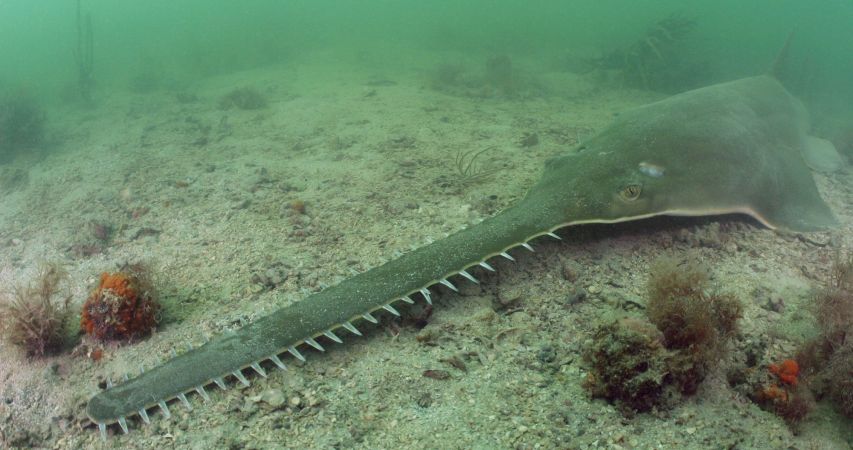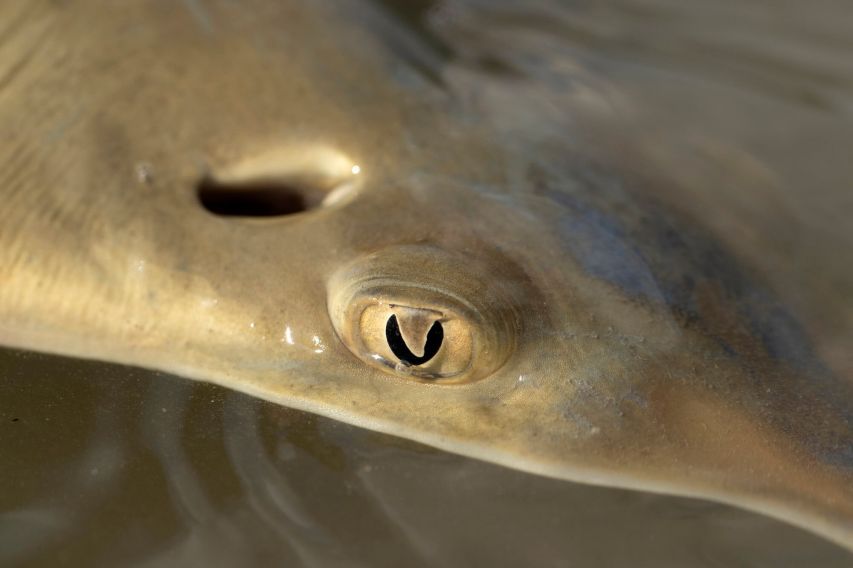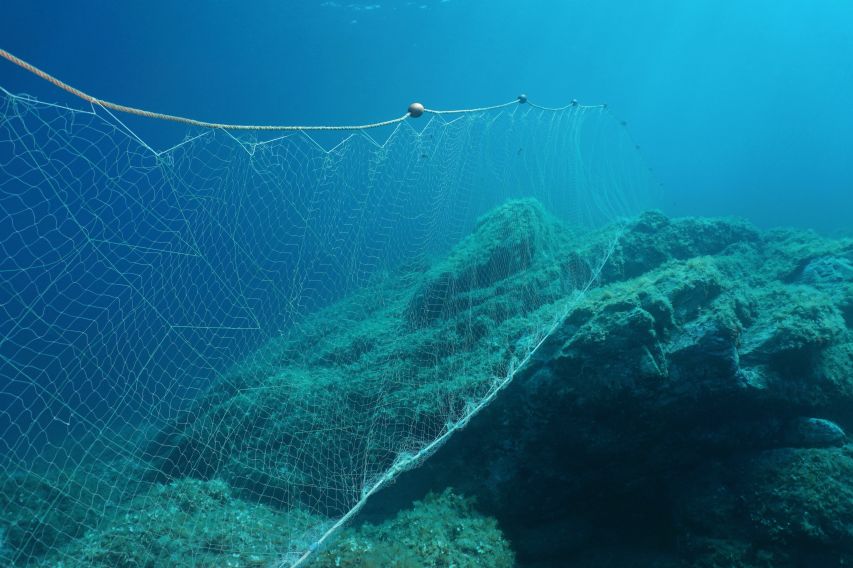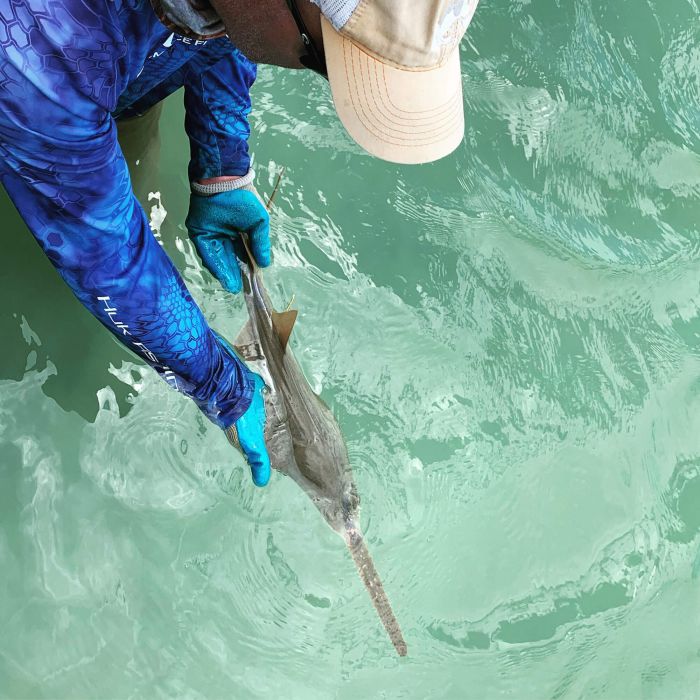
A very rare and curious-looking ray called the smalltooth sawfish inhabits the waters of Florida in the US. Once on the verge of extinction, the animal is now making a comeback thanks to the dedication of scientists, experts, authorities, and the community. This story brings a ray of hope for other endangered rays and sharks around the world.
The smalltooth sawfish (Pristis pectinata) is one of five sawfish species belonging to one of the most threatened shark and ray families.1 With very peculiar looks, the smalltooth sawfish is hard to forget, mostly thanks to a very strange-looking snout – an elongated rostrum with teeth on each side, resembling a saw (hence the saw-fish) or a hedge trimmer. Only found in the Atlantic Ocean, these animals can weigh up to 350 kilos, reach 5 meters in length and live to 30 years. Sadly, these impressive creatures – like many other sharks and rays – are vulnerable to fishing because they grow and mature slowly and have few babies. Today, the smalltooth sawfish is critically endangered – only one step away from extinction in the wild, according to the IUCN Red List of Threatened Species TM. The worrying plight of the species was recognized in 2007 when all international commercial trade in the species and its products (including fins and rostra) was completely banned.

Once upon a time...
“If I was to put you on a time capsule and bring you back in time to the 1920s-1930s, you would find [the smalltooth] sawfish ranging all the way up into North Carolina, and throughout the Gulf of Mexico. But what we had seen as we move forward in time is the range of sawfish started to shrink, getting smaller, and smaller, and smaller,” reveals a sawfish expert Dr. John Carlson, Research Fish Biologist at NOAA Fisheries, and a member of the Smalltooth Sawfish Recovery Implementation Team, from Panama City, US. Today, the smalltooth sawfish can only be found in 20% of its historical range and populations have declined by 95% since the 1920s.2 But how come such an amazing creature has become so rare?

There really were two main threats that jeopardized the long-term survival of the sawfish – bycatch (when an animal is accidentally caught while fishing for other species) and habitat destruction. Although the toothy saw makes the sawfish so special, it readily gets entangled in fishing nets and impossible to free itself. Gill nets – fishing nets hanging vertically like underwater curtains – are particularly dangerous for the sawfish. Typically, in the past, when fishers found an entangled sawfish, they would usually kill it or cut off the rostrum before releasing the animal. Regardless, it meant death for the smalltooth sawfish.
Another threat was the destruction and disappearance of mangroves, which young sawfish use as nursing grounds. Fewer mangroves meant fewer places for the baby sawfish to hide from predators, grow, and mature.
Sadly, as Dr. Carlson explains, “not only in the United States, but throughout the world, mangroves are one of the most endangered tropical forests.”

By the early 2000s, the plight of the smalltooth sawfish in the US was so alarming that in 2003 the species was the first marine fish to get listed under the national Endangered Species Act 1973 (ESA). The listing made mishandling, injuring, or killing the animals illegal. A recovery plan to restore populations had to be developed as well, to ensure that eventually the sawfish is no longer “endangered” in the country. Six years later, a multidisciplinary team of experts launched the Smalltooth Sawfish Recovery Plan, which laid out all the aims, objectives, and planned activities – including public education and protecting mangroves – to bring the species back from the brink. One critical milestone was a 1994 Florida ban of all entangling nets (including gill nets) in state waters. Even though the ban was introduced to protect a different, commercial fish species, it was one of the most important factors enabling recovery as it reduced the main reason why sawfish were dying in the first place.

Recovery work has been underway now for years and the efforts are paying off as experts and communities alike start seeing positive signs that a recovery is taking place!
“Through public encounter records and some of our own science, we are beginning to see sawfish return to some of [their] historical areas,” Dr. Carlson reveals. “Recently, [a researcher] found that in just a short span of 10 years, the effective population size [of the smalltooth sawfish] has increased by several hundred,” he adds.
Now, an optimistic projection suggests a full recovery could be achieved in 40-50 years, which would be twice as fast as originally estimated.3
As this success story shows, it is possible to bring rays back from the brink of extinction and recover threatened populations. This is what our Shark and Ray Recovery Initiative will aim to achieve for some of the most threatened shark and ray species in their last remaining refuges around the world. SARRI has been designed to catalyze a much broader wave of recovery efforts as well. But with over 200 species currently at risk, this will be an enormous task. The good news is that everybody can play a part! Find out how you could help.
Photo by Michael Scholl and Olivier Born was taken under the authority of NMFS ESA permit #22078.
Research and photography by NOAA Fisheries conducted under guidelines of ESA permit #22078 and ENP permit Sci #037.
[1] Three species are critically endangered and two are endangered, according to the IUCN Red List of Threatened Species TM.
[2] Dulvy et al., 2016
[3] 'Scientist notices signs of sawfish population recovering', News Channel 7 WJHG, 2018

Monday, October 10, 2022
The second webinar from our SARRI Expert Webinar series is coming up on 25 October. The session will focus on interdisciplinary approaches for understanding and managing shark and ray fisheries and will be led by Dr. Hollie Booth (University of Oxford; Human Dimensions Working Group, IUCN SSC Shark Specialist Group). Dr. Booth will present methods and findings of her PhD research, which can help to devise management strategies for reducing the mortality of endangered sharks and rays as part of a recovery plan, whilst also considering the income and well-being of coastal communities.

Friday, August 12, 2022
Preventing extinctions has been a primary aim of shark and ray conservation for decades, but the numbers don’t lie. These efforts haven’t kept pace with the threats. We all need to raise our level of ambition if we want to reverse the tragic loss of biodiversity in our ocean. More efforts are needed to actively recover depleted populations for the benefit of our ocean and people who depend on it.

Tuesday, July 12, 2022
The first of the expert webinars will be held on the 27th July, 2022. The founding partners will provide an overview of the shark and ray crisis, SARRI and the toolbox, and what to expect in the coming months and years.
© 2024 SARRI
All rights reserved.
Website by Roojai